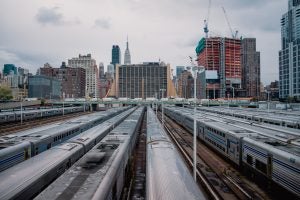 A version of this piece originally ran on City and State New York.
A version of this piece originally ran on City and State New York.
New York City’s mass transit system – the foundation of the city’s density, dynamism and environmental efficiency – is in a state of emergency, putting climate goals and the health of New Yorkers at risk. Congestion pricing can help.
Low carbon footprint
In many ways, New York is a national model for climate action. Both New York state and New York City have committed to reducing greenhouse gas emissions 80 percent by 2050 – ambitious climate goals that are all the more important given the recent Intergovernmental Panel on Climate Change report. In order to achieve those goals, local governments, including New York City, have released ambitious plans to end their dependence on carbon-based energy.
New Yorkers, especially those with access to public transit, already boast an impressively low carbon footprint: New York City residents’ greenhouse gas emissions per capita are about one-third of the U.S. average. New Yorkers across the state help make this possible by using low-carbon transportation – when it’s affordable and available – to move into and around the New York City metropolitan region.
New York’s broken transit system is barrier to achieving ambitious climate goals Share on XWith nearly half of the state’s population in the New York City metro area, maintaining positive momentum on this low-polluting lifestyle is critical to achieving both the city’s and the state’s goals for climate protection, as well as for opportunity and growth in the low-carbon economy of the future.
Public transit in crisis
For many of the roughly 5.6 million daily commuters who rely on the city’s subways, the “Summer of Hell” never ended. The subway system is plagued by delays and unpredictable service. A recent study by Riders Alliance showed there was only one morning rush in August without a major subway failure. In 2016, subway ridership dropped for the first time in years, and it fell again in 2017, even with a rising population in the city.
With the subway falling short, buses aren’t making up the difference. Bus ridership in the city fell 6 percent last year, continuing a decade long trend of declining ridership and representing the largest annual percentage drop in 15 years.
That’s likely because transportation above ground is not any better than below. In addition to widely varying wait times, New York City’s buses are the slowest of any large city in the country.
For those who can afford it, many New Yorkers are turning to personal or for-hire vehicles to get where they’re going, clogging the streets with pollution-spewing vehicles. South of 60th Street, vehicles move at 7.1 mph on average, down from 9.1 mph in 2012. In midtown Manhattan, average speeds are an abysmal 5 mph.
Threat to climate progress
These alarming trends threaten to increase New York’s carbon footprint. Transportation already makes up almost a third of New York City’s greenhouse gas emissions, with the majority of that pollution coming from gasoline and diesel. On-road vehicles account for 96 percent of emissions from transportation.
As climate change shows its teeth – intensifying hurricanes, heat waves and wildfires across the country – we need more people riding mass transit and fewer cars on the road that are using fossil fuels, and fast. An efficient, modern transportation sector would include a range of low-pollution options: innovative public transit with up-to-date sensors and signals to increase capacity and reliability; a transition to electric vehicles for buses, trucks and cars; and increased transit access in communities that don’t have it today.
With a public transit system that’s falling apart, New York threatens to increase its transportation emissions – just as we should be moving to aggressively cut pollution.
Fortunately, we have a comprehensive, ambitious roadmap to fix and modernize both the transit system and improve the effectiveness of how money is spent on capital projects. New York City Transit’s Fast Forward Plan lays out a pathway to fix the subways, expand service to underserved communities, deliver new solutions for “transit deserts” and transition the city’s bus fleet to electricity. It’s a great roadmap. But there’s no funding source in place to make it happen.
How do we fund this vision in a fair and effective way? The most viable answer to this question is clear: adopt a comprehensive congestion pricing system for trucks and cars in the most congested parts of the city. That would be a climate twofer: reducing polluting private cars while funding improved transit service. Without congestion pricing or a similar comprehensive transportation funding policy, New York risks exacerbating the climate change that threatens to inundate its coastlines and make its summers more miserable.
With a rapidly changing climate, we’re in a race for our lives. Gov. Andrew Cuomo recently declared congestion pricing as the “only realistic option” to fund subway improvements, and he’s right. It’s time for elected state leaders to put their money where their mouth is on climate action, and invest in New York’s public transit.









